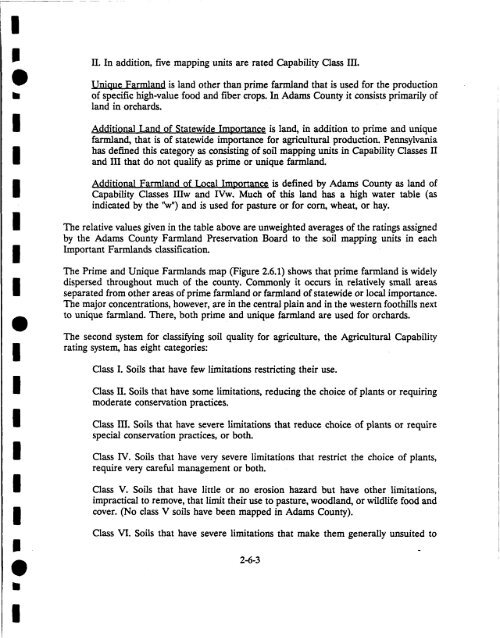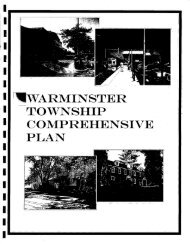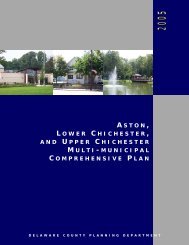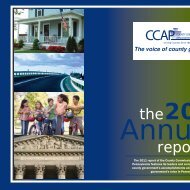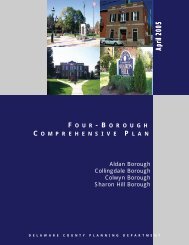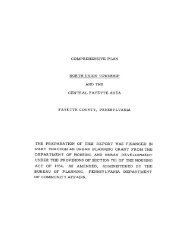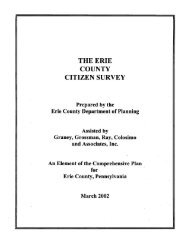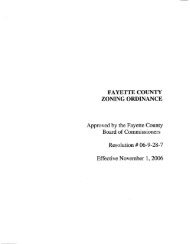- Page 1 and 2:
Norman Day Associates in associatia
- Page 3 and 4:
CONSULTANT TEAM Norman Day Associat
- Page 5 and 6:
L 1 ‘I 1 I I 1 I 1 1 1 1 1 TABLE
- Page 7 and 8:
- Table # 2.6.12 Comparison of All
- Page 9 and 10:
Fimre No. - Title psrre 2.6.2 Gener
- Page 11 and 12:
I-- Table # 2.10.9 - Title Survey o
- Page 13 and 14:
Figure No. 3.4.9 Widening for Turni
- Page 15 and 16:
Figure 1.1 Location of Adams County
- Page 17 and 18:
Littlestown, Fairfield, Arendtsvill
- Page 19 and 20:
would need to place more than the u
- Page 21 and 22:
allowed participants in the compreh
- Page 26 and 27: CHAPTER 2: EXISTING CONDITIONS L SE
- Page 28: family detached dwellings, semi-det
- Page 31 and 32: five-or-more units approved during
- Page 33 and 34: I I Table 23.1 Units and Lots in Re
- Page 35 and 36: I Table 2.33 Housing Totals and Per
- Page 40 and 41: I I SECTION 4: NATURAL RESOURCES As
- Page 42 and 43: county. Along the South Branch of C
- Page 44 and 45: I I b I I 1 I I I l I I I 1 I I The
- Page 46: I I I I I I 1 I I development on ac
- Page 54 and 55: south-central portion of the county
- Page 56 and 57: as the Northern Fruitbelt. It exten
- Page 58 and 59: Sources of Information The most imm
- Page 60 and 61: The National Register Currently, Ad
- Page 62 and 63: approximately ninety mills, over fo
- Page 64 and 65: local recognition of their historic
- Page 66 and 67: listing on a county-wide basis. 8 I
- Page 68 and 69: e considered the peak "period of si
- Page 74 and 75: - 1 I SECTION 6: AGRICULTURAL RESOU
- Page 78 and 79: the open land is in tracts of 100 a
- Page 80 and 81: I I Table 2.6.12 indicates that, in
- Page 82 and 83: Farmland Protection Bureau) and app
- Page 84 and 85: I Li Table 2.6.2 Area in Farms and
- Page 86 and 87: I L Table 2.6.4a Open Land by Agric
- Page 88 and 89: U I Table 2.6.5a Size Distribution
- Page 90 and 91: I 1 ,- Table 2.6% Size Distribution
- Page 92 and 93: 8 m L I I I I I 1 Table 2.6.7 Tps o
- Page 94 and 95: Table 2.6.9 Characteristics of Farm
- Page 96 and 97: ' Table 2.6.11 Economic Measures of
- Page 98 and 99: 1 Table 2.6.13 Agricultural Infrast
- Page 103 and 104: SECTION 7: POPULATION, HOUSING, AND
- Page 105 and 106: ' L 111 I I 1 1 I I Age Characteris
- Page 107 and 108: ‘I population growth rate for six
- Page 109 and 110: I L Comprehensive employment data b
- Page 111 and 112: ' m b 1 I I I I I 1 1 I I I I I com
- Page 113 and 114: Table 2.7.1 - 1960 - 1970 - 1990 Po
- Page 115 and 116: Figure 2.7.2 Adams County Township
- Page 117 and 118: Figure 2.7.4 Adams County Borough P
- Page 119 and 120: Table 2.7.3 Population Density in A
- Page 121 and 122: L I 1 I 1 1 I I I I I I I B Table 2
- Page 123 and 124: I I a b I I 1 I I I m I I I I 1 I B
- Page 125 and 126: Figure 2.7.6 Alternative Population
- Page 127 and 128:
I 1 Table 2.7.11 Indushy Employment
- Page 129 and 130:
Table 2.7.13 Alternative Employment
- Page 131 and 132:
0 m I 1 I I I I 0 1 1 i 1 I I I e L
- Page 133 and 134:
Lincoln Square/DoMltm Gettysburg 1
- Page 135 and 136:
PA Route 194 High LOW 946 north of
- Page 137 and 138:
I 1 L I 1 I I I 1 a 0 a 0 a a 0 a P
- Page 139 and 140:
1972 ComD rehensive Pla Pennsvlvani
- Page 141 and 142:
Accident Analysis L 1 I 1 I I 1 Acc
- Page 143 and 144:
L 0 L 1 Route 15, including three r
- Page 145 and 146:
I e -e L I I 1 I I I a I I i I I I
- Page 147:
I I Table 28.4 I I I I I I Study In
- Page 154 and 155:
Wilson College, in Chambersburg; Mo
- Page 156 and 157:
esponsible for the overall operatio
- Page 158 and 159:
PennDOT has a road maintenance depo
- Page 160 and 161:
Table 2.9.lb Adams County Public Sc
- Page 162 and 163:
Table 2.9.2 Enrollments I I a Adams
- Page 164:
Table 2.9.4b Adam County Fire Servi
- Page 171 and 172:
Figure 2.10.1 Average Annual Water
- Page 173 and 174:
Table 2.10.1 Municipal tuui Communi
- Page 175 and 176:
Table 2.10.2 provides data on the s
- Page 177 and 178:
Most of the wells in this area are
- Page 179 and 180:
Site 22 - Pine Run, in Hamilton Tow
- Page 181 and 182:
Table 2.103 Munikipal Sewer Systems
- Page 183 and 184:
wastewater to flow from the drain f
- Page 185 and 186:
and broad gentle dopes broken by sh
- Page 187 and 188:
The area of severe limitation occup
- Page 189 and 190:
The above facilities, as well as on
- Page 191 and 192:
Solid Waste I 1 A wide variety of s
- Page 193 and 194:
The 66,000 tons-per-year figure giv
- Page 195 and 196:
some ancillary services such as fam
- Page 197 and 198:
capacity. Household Hazardous Waste
- Page 199 and 200:
Agricultural Residues Similar to in
- Page 201 and 202:
February through June, and none in
- Page 203:
Television In addition to individua
- Page 209 and 210:
I I L I * A EME - SECTION 1: GENERA
- Page 211 and 212:
I L m I I I I I I I I I I I I c SEC
- Page 213 and 214:
I II 0 L I I I I I I e I I I I I I
- Page 215 and 216:
1 I 0 L I I I I I I I I I I I I I e
- Page 217 and 218:
1 L L I I I I I I I I I I I I II Ob
- Page 219 and 220:
Act (preferential tax assessment),
- Page 221 and 222:
of the Growth Management Plan. Grow
- Page 223 and 224:
county's historic and rural landsca
- Page 225 and 226:
permanent open space system, should
- Page 227 and 228:
Industrial Uses The Land Use Plan i
- Page 229 and 230:
traditional locations such as the i
- Page 231 and 232:
oroughs, but regulated by new, perf
- Page 233 and 234:
A 0 nd Use Policieg 1. Promote the
- Page 235 and 236:
Figure 333 “Country Cluster“ 10
- Page 238 and 239:
I 1 SECTION 4: CIRCULATION PLAN Int
- Page 240 and 241:
Implementation of a new roadway lin
- Page 242 and 243:
1 1 7. Safety Improvements m I 1 I
- Page 244 and 245:
1 L - Level ‘E west of Bonneauvil
- Page 246 and 247:
1 1 L I I I I I -1 A free access ro
- Page 248 and 249:
C Littlestown-Hmover Road Extension
- Page 250 and 251:
C. Cross Xeys-Littlestown Connector
- Page 252 and 253:
I I b I I I I I 1 I I I 1 I I I_ sh
- Page 254 and 255:
I I L I I I I I I I 1 I I I I II Ei
- Page 256 and 257:
I I L 1 I 1 I I I I 1 I I I I II Mu
- Page 258 and 259:
1 8 5 i I 1 I 1 I presented in Tabl
- Page 260 and 261:
e D I 1 I I I I 0 I 1 I I I 8 r 0 I
- Page 262 and 263:
7. Adopt Access Management Standard
- Page 264 and 265:
~ ~~ _____ Table 3.46 Levels of Ser
- Page 266 and 267:
Table 3.4.3 Recommended Circulation
- Page 268:
1 m Table 3.43 - Recommended Circul
- Page 271 and 272:
WIDENING FROM TWO TO FIVE LANES ADA
- Page 273 and 274:
F44ue 3.4.61 CONCEPT- COUNTY COLLEC
- Page 275 and 276:
TYPICAL SECTION, RURAL-STYLE COUNTY
- Page 277:
1 flgwet4.2 RIGHT-OF-WAY RESERVE FO
- Page 283 and 284:
tract considered for development. F
- Page 285 and 286:
encourages developers to set aside
- Page 287 and 288:
of the current housing stock. Incre
- Page 289 and 290:
Conewago Valley and, to a lesser ex
- Page 291 and 292:
nationally-significant historic set
- Page 293 and 294:
SECTION 7: HISTORIC AND LANDSCAPE R
- Page 295 and 296:
1 I 1 I I 1 closely with individual
- Page 297 and 298:
‘I instrumental in the conservati
- Page 299 and 300:
I character of historic resources b
- Page 301 and 302:
I 1 0 Ir I 1 1 I I 1 e e County Off
- Page 303 and 304:
esources by creating model ordinanc
- Page 305 and 306:
The Plan advocates a number of prog
- Page 307 and 308:
dent locations must be provided for
- Page 309 and 310:
The County should also oppose utili
- Page 311 and 312:
establishment of a conservancy or l
- Page 313 and 314:
4. The allowable units should be gr
- Page 315 and 316:
Table 3.8.1 Goals, Objectives, and
- Page 317 and 318:
Figure 3.8.1 Municipalities in York
- Page 319 and 320:
SECTION 9: UTILITIES PLAN Introduct
- Page 321 and 322:
percolates through the earth to sup
- Page 323 and 324:
depending on the duration of the dr
- Page 325 and 326:
I I ~ ~ ~ ~ i i I I Figure 393 Pote
- Page 327 and 328:
The groundwater resources lie in th
- Page 329 and 330:
Figure 3.9.4a Countywide Centralize
- Page 331 and 332:
1 L L I 1 I II I I part of the coun
- Page 333 and 334:
1 I Site 16 - Bermudian Creek in Ty
- Page 335 and 336:
Figure 3.9.5 Well-Head Protection U
- Page 337 and 338:
I L a b I I I I I I 0 I I I I I I I
- Page 339 and 340:
I I h I I I I I I I I I I I I I Lit
- Page 341 and 342:
I I h I I I I I I I I I I I I II Pr
- Page 343 and 344:
supply wells. 4. Promote water cons
- Page 345 and 346:
not available at the time of the or
- Page 347 and 348:
equiring developers to base the num
- Page 349 and 350:
I b I I I I I I c- R FOUR : IMPLEME
- Page 351 and 352:
County Administration The County al
- Page 353 and 354:
LAND USE Policy Statement Promote t
- Page 355 and 356:
LAND USE - Policy Statement Promote
- Page 357:
CIRCULATION Policy Statement 1) Con
- Page 360 and 361:
Qclors Assist municipalities in the
- Page 362 and 363:
~ kOMMUNlTY FACILITIES Policy State
- Page 364 and 365:
APE RESOURCES 4cturs Adams County C
- Page 366 and 367:
iiisroRic AND LAND! Policy Statemen
- Page 368 and 369:
AGRICULTURAL RES( Policy Statenimt
- Page 370 and 371:
RCES kctors Municipalities Permit f
- Page 372 and 373:
~ -~ ~ ~ UTII,ITI ES PLAN Policy St
- Page 374 and 375:
UTILITIES PLAN Policy Stvtcmcnt Lct
- Page 376 and 377:
ENVIRONMENTAL PR Policy Statmien1 r
- Page 378 and 379:
I n 1 -ZE8 t 0 W 0 61 3lMtlw ul 1 +
- Page 380 and 381:
Littlestown Community Evenlng Peak
- Page 382 and 383:
W 0 1 0 r12miles * 3 miles 5 314 mi
- Page 384 and 385:
clll G t c Orlh Rodger$& Associales
- Page 386 and 387:
U.S. Route Route 15 Evening Peak Ho


